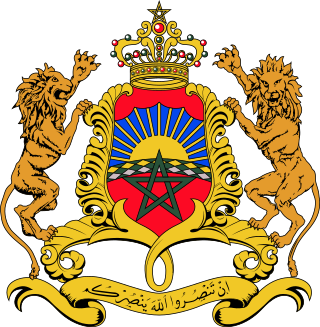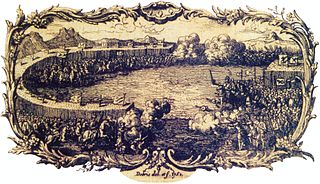
Moulay Ismail Ibn Sharif, born around 1645 in Sijilmassa and died on 22 March 1727 at Meknes, was a Sultan of Morocco from 1672 to 1727, as the second ruler of the 'Alawi dynasty. He was the seventh son of Moulay Sharif and was governor of the province of Fez and the north of Morocco from 1667 until the death of his half-brother, Sultan Moulay Rashid in 1672. He was proclaimed sultan at Fez, but spent several years in conflict with his nephew Moulay Ahmed ben Mehrez, who also claimed the throne, until the latter's death in 1687. Moulay Ismail's 55-year reign is the longest of any sultan of Morocco. During his lifetime, Moulay amassed a harem of over 500 women with more than 800 confirmed biological children, making him one of the most prodigious fathers in recorded history.

The 'Alawi dynasty – also rendered in English as Alaouite, 'Alawid, or Alawite – is the current Moroccan royal family and reigning dynasty. They are an Arab sharifian dynasty and claim descent from the Islamic prophet Muhammad through his grandson, Hasan ibn Ali. Their ancestors originally migrated to the Tafilalt region, in present-day Morocco, from Yanbu on the coast of the Hejaz in the 12th or 13th century.

The Battle of Alcácer Quibir was fought in northern Morocco, near the town of Ksar-el-Kebir and Larache, on 4 August 1578.

El Jadida is a major port city on the Atlantic coast of Morocco, located 96 kilometres (60 mi) south of the city of Casablanca, in the province of El Jadida and the region of Casablanca-Settat. It has a population of 170,956 as of 2023.
Sidi Mohammed ben Abdallahal-Khatib, known as Mohammed III, born in 1710 in Fes and died on 9 April 1790 in Meknes, was the Sultan of Morocco from 1757 to 1790 as a member of the 'Alawi dynasty. He was the governor of Marrakesh around 1750. He was also briefly sultan in 1748. He rebuilt many cities after the earthquake of 1755, including Mogador, Casablanca, and Rabat, and Abdallah Laroui described him as "the architect of modern Morocco." He also defeated the French in the Larache expedition in 1765 and expelled the Portuguese from Mazagan (al-Jadīda) in 1769. He is notable for having been the leader of one of the first nations to recognize American independence in his alliance with Luis de Unzaga 'le Conciliateur' through correspondence and Unzaga's secret intelligence service and led by his brothers-in-law Antonio and Matías de Gálvez from the Canary Islands. He was the son of Mawlay Abdallah bin Ismail and his wife a lady of the Chéraga guich tribe.

Elvas is a Portuguese municipality, former episcopal city and frontier fortress of easternmost central Portugal, located in the district of Portalegre in Alentejo. It is situated about 200 kilometres (120 mi) east of Lisbon, and about 8 kilometres (5.0 mi) west of the Spanish fortress of Badajoz, by the Madrid-Badajoz-Lisbon railway. The municipality population as of 2011 was 23,078, in an area of 631.29 square kilometres (243.74 sq mi). The city itself had a population of 16,640 as of 2011.
MawlayMohammed al-Shaykh al-Sharif al-Hassani, known as Mohammed al-Shaykh, was the first sultan of the Saadian dynasty of Morocco (1544–1557). He was particularly successful in expelling the Portuguese from most of their bases in Morocco. He also eliminated the Wattasids and resisted the Ottomans, thereby establishing a complete rule over Morocco.

Moroccan–Portuguese conflicts refer to a series of battles between Morocco and Portugal throughout history including Battle of Tangier, Fall of Agadir and other battles and sieges in the Moroccan coast.

Castelo Real was a Portuguese castle established in Mogador, now Essaouira in Morocco, by the Portuguese in 1506.

Morocco–Portugal relations cover a period of several centuries largely historic, and to present not particularly substantial relations. Initial contacts started in the 8th century, when Muslim forces invaded most of the territory of the Iberian peninsula. After the Reconquista, Portugal would then expand into Africa, starting with the territory of Morocco, by invading cities and establishing fortified outposts along the Moroccan coast.

The siege of Larache, in 1689, was undertaken by an army of Morocco under 'Alawid Sultan Ismail Ibn Sharif against the Spanish forces of Charles II, which had ruled the city for almost 80 years since its cession in 1610. After three months of siege, the defenders were forced to capitulate.

The Castle of Alenquer, is a Portuguese medieval castle in civil parish of Alenquer, in the municipality of Alenquer, in the district of Lisbon.

D. Luís Carlos Inácio Xavier de Meneses, 1st Marquis of Louriçal, 5th Count of Ericeira,, was a Portuguese nobleman and statesman, that served as Viceroy of India twice.

Portuguese Tangier covers the period of Portuguese rule over Tangier, today a city in Morocco. The territory was ruled by the Kingdom of Portugal from 1471 to 1661.

Pedro I was a ship of the line of the Imperial Brazilian Navy. It was a third-rate, three-masted, two-decked, 74-gunned sailing ship. The ship was built by shipbuilder Antônio da Silva in the Bahia Navy Arsenal in Salvador for the Portuguese navy in Colonial Brazil in 1763. First named Santo António e São José, it took part in several naval actions in the decades after its construction such as the bombardment of Algiers in 1784.

The 1562 Siege of Mazagan, also known as the Great Siege of Mazagan was an armed engagement that took place in the modern city of El Jadida, then known as Mazagan, between Portuguese forces and those of the Saadi dynasty, which had unified Morocco a few years prior.

Portuguese Asilah covers the period of Portuguese rule over Asilah, today a city in Morocco. The territory was ruled by the Kingdom of Portugal from 1471 to 1550 and again between 1577 and 1589.
In 1640, the Moroccans led by Sidi al-Ayachi ambushed a Portuguese force from Mazagan, successfully killing most of them, including their commander.















